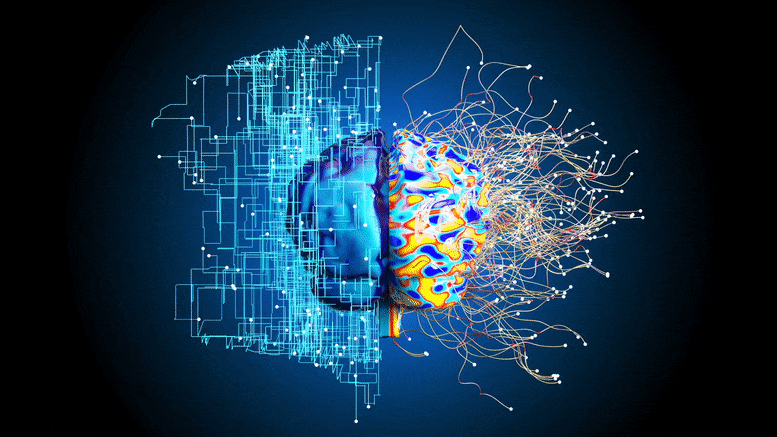
[ad_1]

ஸ்கிரிப்ஸ் ரிசர்ச் ஆராய்ச்சியாளர்கள் மூளை பிளாஸ்டிசிட்டியை கண்காணிக்க ஒரு புதிய கருவியை உருவாக்கியுள்ளனர்.
Scripps Research இன் ஆராய்ச்சியாளர்கள் மூளையின் செயல்பாட்டிற்கு பதிலளிக்கும் விதமாக மூளை செல்களில் உள்ள பல்வேறு புரதங்களின் அளவுகள் எவ்வாறு மாறுகின்றன என்பதை ஆய்வு செய்தனர்.
ஸ்கிரிப்ஸ் ஆராய்ச்சி நிறுவனம் மூளை பிளாஸ்டிசிட்டியை கண்காணிக்க விஞ்ஞானிகள் ஒரு புதிய கருவியை உருவாக்கியுள்ளனர் – ஒரு திரைப்படத்தைப் பார்ப்பது அல்லது ஒரு புதிய பாடல் அல்லது மொழியைக் கற்றுக்கொள்வது போன்ற புதிய விஷயங்களைக் கற்று அனுபவிக்கும்போது நமது மூளை மறுவடிவமைத்து உடல் ரீதியாக சரிசெய்யும் செயல்முறை. பல்வேறு மூளை உயிரணு வகைகளால் உருவாக்கப்படும் புரதங்களை ஆய்வு செய்யும் அவர்களின் முறை, மூளை எவ்வாறு செயல்படுகிறது என்பதற்கான அடிப்படை விளக்கங்களை வழங்குவதோடு, பிளாஸ்டிசிட்டி செயலிழக்கும் மூளையின் பல நோய்களைப் பற்றிய நுண்ணறிவை வழங்கும் திறனைக் கொண்டுள்ளது.
பல ஆய்வகங்களில் நடத்தப்பட்ட முந்தைய ஆராய்ச்சி, பிளாஸ்டிசிட்டியின் ஆரம்ப கட்டமான நியூரான்களில் மரபணு வெளிப்பாட்டில் ஏற்படும் மாற்றங்களை மூளையின் செயல்பாடு எவ்வாறு தூண்டுகிறது என்பதைக் காட்டுகிறது. குழுவின் ஆராய்ச்சி, இது சமீபத்தில் வெளியிடப்பட்டது நியூரோ சயின்ஸ் இதழ்பிளாஸ்டிசிட்டியின் அடுத்த முக்கியமான கட்டத்தில் கவனம் செலுத்துகிறது – மரபணு குறியீட்டை புரதங்களாக மாற்றுவது.
“அனுபவங்களுக்கு ஏற்ப நமது மூளையில் உள்ள செல்கள் எவ்வாறு மாறுகின்றன என்பதன் அடிப்படையிலான அனைத்து வழிமுறைகளையும் நாங்கள் இன்னும் புரிந்து கொள்ளவில்லை, ஆனால் இந்த அணுகுமுறை செயல்முறைக்கு ஒரு புதிய சாளரத்தை அளிக்கிறது” என்கிறார் ஹான் பேராசிரியரும் தலைவருமான ஹோலிஸ் க்லைன், Ph.D. ஸ்கிரிப்ஸ் ஆராய்ச்சியில் நரம்பியல் மற்றும் புதிய படைப்பின் மூத்த எழுத்தாளர்.
நீங்கள் புதிதாக ஒன்றைக் கற்றுக் கொள்ளும்போது இரண்டு விஷயங்கள் நடைபெறுகின்றன: முதலில், உங்கள் மூளையில் உள்ள நியூரான்கள் உடனடியாக புதிய நரம்பியல் பாதைகளில் மின் சமிக்ஞைகளை அனுப்புகின்றன. இது இறுதியில் மூளை உயிரணுக்களின் உடல் அமைப்பு மற்றும் அவற்றின் இணைப்புகளில் மாற்றங்களை ஏற்படுத்துகிறது. ஆனால் நீண்ட காலமாக, விஞ்ஞானிகள் இந்த இரண்டு படிகளுக்கு இடையில் என்ன நடக்கிறது என்று ஆச்சரியப்படுகிறார்கள். நியூரான்களில் இந்த மின் செயல்பாட்டின் விளைவாக மூளை எவ்வாறு கணிசமான மாற்றங்களுக்கு உட்படுகிறது? மேலும், வயதான மற்றும் சில நோய்களால் இந்த பிளாஸ்டிசிட்டி எப்படி, ஏன் மோசமடைகிறது?
முன்னதாக, மூளையின் செயல்பாட்டிற்கு பதிலளிக்கும் விதமாக நியூரான்களில் உள்ள மரபணுக்கள் எவ்வாறு இயங்குகின்றன மற்றும் அணைக்கப்படுகின்றன என்பதை ஆராய்ச்சியாளர்கள் ஆய்வு செய்தனர். உயர்-செயல்திறன் மரபணு வரிசைமுறை தொழில்நுட்பங்களின் வருகையுடன், இந்த வழியில் மரபணுக்களைக் கண்காணிப்பது ஒப்பீட்டளவில் எளிதானது. ஆனால் அந்த மரபணுக்களில் பெரும்பாலானவை புரதங்களை குறியாக்கம் செய்கின்றன – உயிரணுக்களின் உண்மையான வேலைக் குதிரைகள், அவற்றின் அளவைக் கண்காணிப்பது மிகவும் கடினம். ஆனால் க்லைன், ஸ்கிரிப்ஸ் பேராசிரியர் ஜான் யேட்ஸ் III, Ph.D. மற்றும் இணைப் பேராசிரியர் Anton Maximov, Ph.D. ஆகியோருடன் நெருக்கமாக இணைந்து மூளையில் உள்ள புரதங்கள் எவ்வாறு மாறுகின்றன என்பதை நேரடியாகப் பார்க்க விரும்பினார்.
“நாங்கள் குளத்தின் ஆழமான முனையில் குதித்து மூளை பிளாஸ்டிசிட்டிக்கு என்ன புரதங்கள் முக்கியம் என்பதைப் பார்க்க விரும்பினோம்,” என்கிறார் க்லைன்.
சிறப்பாகக் குறியிடப்பட்ட அமினோவை அறிமுகப்படுத்தக்கூடிய ஒரு அமைப்பைக் குழு வடிவமைத்தது[{” attribute=””>acid—one of the building blocks of proteins—into one type of neuron at a time. As the cells produced new proteins, they would incorporate this amino acid, azidonorleucine, into their structures. By tracking which proteins contained the azidonorleucine over time, the researchers could monitor newly made proteins and distinguish them from pre-existing proteins.
Cline’s group used the azidonorleucine to track which proteins were made after mice experienced a large and widespread spike in brain activity, mimicking what happens at a smaller scale when we experience the world around us. The team focused on cortical glutamatergic neurons, a major class of brain cells responsible for processing sensory information.
After the increase in neural activity, the researchers discovered levels of 300 different proteins changed in the neurons. While two-thirds increased during the spike in brain activity, the synthesis of the remaining third decreased. By analyzing the roles of these so-called “candidate plasticity proteins”, Cline and her colleagues were able to gain general insight into how they might impact plasticity. Many of the proteins are related to the structure and shape of neurons, for instance, as well as how they communicate with other cells. These proteins suggested ways in which brain activity can immediately begin to impact connections between cells.
Additionally, a number of the proteins were related to how DNA is packaged inside cells; changing this packaging can change which genes a cell can access and use over a long time period. This suggests ways that a very short spike in brain activity can lead to more sustained remodeling within the brain.
“This is a clear mechanism by which a change in brain activity can lead to waves of gene expression for many days,” says Cline.
The researchers hope to use this method to discover and study additional candidate plasticity proteins, for instance those that might change in different types of brain cells after animals see a new visual stimulus. Cline says their tool also could offer insight into brain diseases and aging, through comparisons of how brain activity impacts protein production in young versus old and healthy versus diseased brains.
Reference: “Activity-Induced Cortical Glutamatergic Neuron Nascent Proteins” by Lucio M. Schiapparelli, Yi Xie, Pranav Sharma, Daniel B. McClatchy, Yuanhui Ma, John R. Yates 3rd, Anton Maximov and Hollis T. Cline, 19 October 2022, JNeurosci.
DOI: 10.1523/JNEUROSCI.0707-22.2022
The study was funded by the National Institutes of Health, the Hahn Family Foundation, and the Harold L. Dorris Neurosciences Center Endowment Fund.
[ad_2]